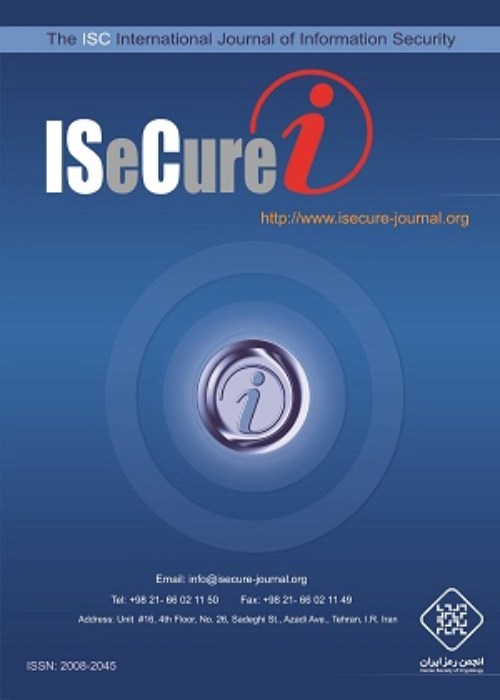فهرست مطالب
International Journal of Information Security
Volume:7 Issue: 2, Jul 2015
- تاریخ انتشار: 1394/12/01
- تعداد عناوین: 7
-
-
صفحات 89-90
-
صفحات 127-134
-
صفحات 151-166
-
Pages 89-90
-
Pages 91-99A multi-secret sharing scheme (MSS) allows a dealer to share multiple secrets among a set of participants. in such a way a multi-secret sharing scheme (MSS) allows a dealer to share multiple secrets among a set of participants، such that any authorized subset of participants can reconstruct the secrets. Up to now، existing MSSs either require too long shares for participants to be perfect secure، or do not have a formal security analysis/proof. In 2013، Herranz et al. provided the first formal definition of computational security for multi-stage secret sharing scheme (MSSS) in the standard model and proposed a practical and secure scheme. As far as we know، their scheme is the only computationally secure MSS in the standard model، and there is no formal definition of the computational security for other categories of MSSs. Based on this motivation، in this paper، we define the first formal model of indistinguishability against the chosen secret attacks (CSA) for other types of MSSs in the standard model. Furthermore، we present two practical CSA-secure MSSs، belonging to different types of MSSs and enjoying the advantage of short shares. They are also provably secure in the standard model. Based on the semantic security of the underlying encryption schemes، we prove the security of our schemes.Keywords: Multi, secret Sharing Scheme, Multi, stage Secret Sharing Scheme, Provable Security, Private, key Cryptosystem, Standard Model
-
Pages 101-114This paper presents two efficient implementations of fast and pipelined bit-parallel polynomial basis multipliers over GF (2m) by irreducible pentanomials and trinomials. The architecture of the first multiplier is based on a parallel and independent computation of powers of the polynomial variable. In the second structure only even powers of the polynomial variable are used. The parallel computation provides regular and low-cost structure with low critical path delay. In addition، the pipelining technique is applied to the proposed structures to shorten the critical path and to perform the computation in two clock cycles. The implementations of the proposed methods over the binary extension fields GF (2163) and GF (2233) have been successfully verified and synthesized using Xilinx ISE 11 by Virtex-4، XC4VLX200 FPGA.Keywords: Bit, parallel Multiplier, Elliptic Curve Cryptography, Trinomials, Pentanomials, Pipelining
-
EEH: AGGH-Like Public Key Cryptosystem over the Eisenstein Integers Using Polynomial RepresentationsPages 115-126GGH class of public-key cryptosystems relies on computational problems based on the closest vector problem (CVP) in lattices for their security. The subject of lattice based cryptography is very active and there have recently been new ideas that revolutionized the field. We present EEH، a GGH-Like public key cryptosystem based on the Eisenstein integers Z [_3] where _3 is a primitive cube root of unity. EEH applies representations of polynomials to the GGH encryption scheme and we discuss its key size and parameters selection. We also provide theoretical and experimental data to compare the security and efficiency of EEH to GGH with comparable parameter sets and show that EEH is an improvement over GGH in terms of security and efficiency.
-
Pages 127-134AES−CMCCv1، AVALANCHEv1، CLOCv1، and SILCv1 are four candidates of the first round of CAESAR. CLOCv1 is presented in FSE 2014 and SILCv1 is designed upon it with the aim of optimizing the hardware implementation cost. In this paper، structural weaknesses of these candidates are studied. We present distinguishing attacks against AES−CMCCv1 with the complexity of two queries and the success probability of almost 1، and distinguishing attacks on CLOCv1 and SILCv1 with the complexity of O (2n/2) queries and the success probability of 0. 63، in which n is bit length of message blocks. In addition، a forgery attack is presented against AVALANCHEv1 which requires only one query and has the success probability of 1. The attacks reveal weaknesses in the structure of these first round candidates and inaccuracy of their security claims.Keywords: Authenticated Encryption, CAESAR, AES−CMCCv1, AVALANCHEv1, CLOCv1, SILCv1, Distinguishing Attack, Forgery Attack
-
Pages 135-149Nowadays Radio Frequency Identification (RFID) systems have appeared in lots of identification and authentication applications. In some sensitive applications، providing secure and confidential communication is very important for end-users. To this aim، different RFID authentication protocols have been proposed، which have tried to provide security and privacy of RFID users. In this paper، we analyze the privacy of two recently proposed RFID authentication protocols in 2012 and 2013. We present several traceability attacks including traceability، backward traceability and forward traceability against the first protocol. We also show that، the second protocol not only suffers from Denial-of-Service (DoS) attack، but also it is vulnerable to traceability and backward traceability attacks. We present our privacy analysis based on a well-known formal RFID privacy model which has been proposed by Ouafi and Phan in 2008. Then، in order to overcome the weaknesses، we apply some modifications on these protocols and propose two modified versions.
-
Pages 151-166Reputation management systems are in wide-spread use to regulate collaborations in cooperative systems. Collusion is one of the most destructive malicious behaviors in which colluders seek to affect a reputation management system in an unfair manner. Many reputation systems are vulnerable to collusion، and some model-specific mitigation methods are proposed to combat collusion. Detection of colluders is shown to be an NP-complete problem. In this paper، we propose the Colluders Similarity Measure (CSM) which is used by a heuristic clustering algorithm (the Colluders Detection Algorithm (CDA)) to detect colluders in O (n2m + n4) in which m and n are the total number of nodes and colluders، respectively. Furthermore، we propose architecture to implement the algorithm in a distributed manner which can be used together with compatible reputation management systems. Implementation results and comparison with other mitigation approaches show that our scheme prevents colluders from unfairly increasing their reputation and decreasing the reputation of the other nodes.


